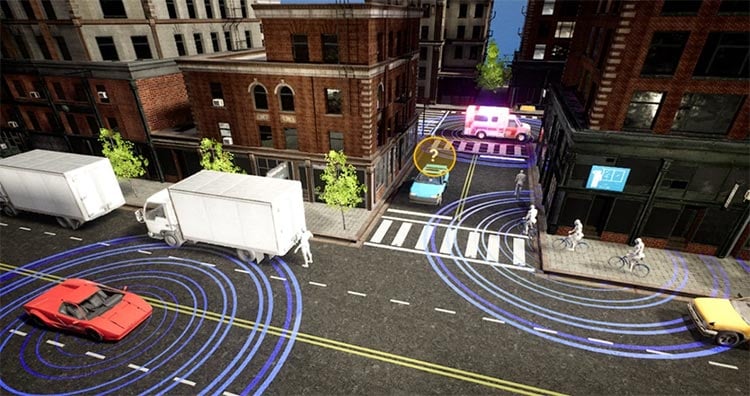自動運転の普及に伴い、ドライバーやオペレータへの依存度が下がるのに従って、従来ドライバーやオペレータが担ってきた様々な活動をより高いレベルの自動運転の実現のために再現する必要があります。 車両やロボット工学は、視覚や触覚だけでなく、音や嗅覚も含めて、人間のドライバーやオペレーターが使用するすべての感覚を利用する必要があります。
SAEによると:
- レベル2の自律性は、ドライバーが次のことを行う必要があることを示しています...環境を監視します。
- レベル 3 の自動運転では、ドライバーによる環境の監視を必須としていません。
- そして、レベル4の自律性に到達すると、車両は...環境を単独で監視することが可能です。
ルネサスのリアリティAIソフトウェアは、今日すでにその環境の監視に役立っています。 高度な運転や運用能力のための製品や車両の外部環境だけでなく、予防保守や予知保全を容易にするための製品自体も含みます。 Reality AIツールは、環境から生成されたさまざまな信号を分析するために利用できる高度な信号処理技術により、より高いレベルの自律性を促進し、車両や製品の安全性を高めることができます。
ルネサスは、自動運転を推進するさまざまな業界向けに、音のセンシングモダリティを含めることで現在のADAS/ADセンサスイートを強化する Seeing with Sound ソリューションを提供しています。 私たちが運転するとき、私たちは視覚だけでなく、聴覚や振動を同時に使いながら、周囲をナビゲートしています。 私たちは周囲の環境から多くの音を聞きますが、その音源はすぐにはわからないか、まったく見えないかもしれません。
SWSは、車両のマイクや振動・音響センサをRH850/U2Aなどのルネサス製マイコンと組み合わせて使用することで、緊急車両や道路上の他の車両、歩行者、さらには自転車の音を聞き取ります。

Seeing with Sound(SWS)アプリケーションは、最近ニューヨークタイムズの記事で話題となった、サイレンが鳴っている緊急車両のロボット車両による妨害のため、緊急事態への到着が遅れるという問題に対する完璧な解決策です。 ロボット車両は対向する消防車に対して明確な視線を持っていましたが、それを認識していませんでした。私たちのSWSソリューションが実装されていれば、確かにサイレンが聞こえたでしょう。 その車両の周囲の聴覚環境は、視覚環境が見逃していた情報を提供し、環境全体のより良いイメージを提供したでしょう。
ルネサスのSeeing with Soundソリューションは、車両が周囲の音を聞き取り、緊急サイレンの音などの関心のある騒音に基づいて決定を下すことを可能にします。 運転中に聴覚をどれだけ活用しているかを見落としてしまうことがあります。 現在の車両においても、注意散漫な運転により注意が道路から離れてしまうことが確認されており、パッシブおよびアクティブノイズキャンセリング技術の利用が一般化することで、人間のドライバーが環境からのすべての入力を認識することがより困難になっています。 SWSを車両に組み込むことで、車両の安全性が向上し、ドライバーへの注意を強いる必要がなくなります。 緊急車両に関する規制やムーブオーバー法、または自動緊急ブレーキは、SWSのようなさまざまな技術の実装を推進しています。
産業界が自律化の傾向を続ける中、車両や製品の運転状況の状態監視や予知保全・予防保全のためのAIの利用は増え続けるでしょう。 私たちは、ドライバーやオペレーターとして、通常、製品や車両の健康状態を監視し、必要なメンテナンスをスケジュールしたり、車両を安全な場所に移動して見栄えを良くしたりします。 ルネサスのReality AIツールは、加速度計、ジャイロ、IMU、マイクロフォンなどのさまざまなセンサからのデータを分析し、周波数/振幅または時間領域の信号メトリックを利用してMLモデルを開発し、数学、統計、対数の定式化に基づいて特徴セットを計算できます。 圧力センサーや温度センサーも使用できます。 フィルターからウォーターポンプ、ウォッシャーポンプ、タイヤの摩耗など、さまざまなアプリケーションに対して、健康状態や残存耐用年数の指標などの結果を生成します。
運転時に監視するさまざまな変数をすべて考慮し、小さな衝撃、衝突、へこみ、引っかき傷などの異常も含めて、音と同様に感じることもできます。 Reality AI Toolsソフトウェアは、これらのさまざまな信号を分析して、それらが何を表しているのかを分類できます。 石や岩がフロントガラスに衝撃を与えた場合はどうなるでしょう? 最初のショックの後、ドライバーがどのような予防措置を講じるべきかを決定できます。 未来の車は、衝撃が起こったことをどうやって知るのでしょうか? 音や触覚、感触を取り入れることで自律能力が向上する状況は多くあります。 産業界が自動運転を目指す中、自動運転製品は、ドライバーと同乗者の安全と快適性を維持するために、さまざまな条件にどのように適応できるのでしょうか?
詳細については、 Automotive Sound Recognition(SWS) のページをご覧いただくか、パッシブオーディオセンシングの展開に関するホワイトペーパー「Seeing with Sound: AI-Based Detection of Participants in Automotive Environment from Passive Audio」をお読みください。 SWSの実演をご覧になる準備ができたら、今すぐ デモをリクエスト してください。



